1.3 Micron Photodetectors Enabled by the SPARK Effect
Abstract
1. Introduction
2. SPARK Effect Theory
3. Device Concept and Fabrication
4. Experimental Results and Discussion
4.1. Electrical Characterization
4.2. Responsivity Measurements
4.3. Time Response
5. Conclusions
Author Contributions
Funding
Data Availability Statement
Acknowledgments
Conflicts of Interest
References
- Jalali, B.; Fathpour, S. Silicon Photonics. J. Light. Technol. 2006, 24, 4600–4615. [Google Scholar] [CrossRef]
- Soref, R. The Past, Present, and Future of Silicon Photonics. IEEE J. Sel. Top. Quantum Electron. 2007, 12, 1678–1687. [Google Scholar] [CrossRef]
- Reed, G.T. Silicon Photonics: The State of the Art; John Wiley & Sons: Hoboken, NJ, USA, 2008; Available online: https://books.google.it/books?hl=it&lr=&id=NVmnuGREwj4C&oi=fnd&pg=PR7&dq=reed+silicon+photonics&ots=IX9RZ1bksw&sig=6KTTsalkIottDejnz8Dr0NlExpQ&redir_esc=y#v=onepage&q=reed%20silicon%20photonics&f=false (accessed on 1 February 2025).
- Thomson, D.; Zilkie, A.; Bowers, J.E.; Komljenovic, T.; Reed, G.T.; Vivien, L.; Marris-Morini, D.; Cassan, E.; Virot, L.; Fédéli, J.M.; et al. Roadmap on Silicon Photonics. J. Opt. 2016, 18, 073003. [Google Scholar] [CrossRef]
- Li, C.; Guo, P.; Xie, S.W.; Luo, L.W.; Siew, S.Y.; Luo, X.; Dong, B.; Zheng, H.Y.; Zhang, W.; Gao, F.; et al. Review of Silicon Photonics Technology and Platform Development. J. Light. Technol. 2021, 39, 4374–4389. [Google Scholar] [CrossRef]
- Yang, W.; Chen, J.; Zhang, Y.; Zhang, Y.; He, J.H.; Fang, X. Silicon-Compatible Photodetectors: Trends to Monolithically Integrate Photosensors with Chip Technology. Adv. Funct. Mater. 2019, 29, 1808182. [Google Scholar] [CrossRef]
- Liu, C.; Guo, J.; Yu, L.; Li, J.; Zhang, M.; Li, H.; Shi, Y.; Dai, D. Silicon/2D-Material Photodetectors: From near-Infrared to Mid-Infrared. Light Sci. Appl. 2021, 10, 123. [Google Scholar] [CrossRef]
- Tang, Y.; Mak, K.F. Nanomaterials: 2D Materials for Silicon Photonics. Nat. Nanotechnol. 2017, 12, 1121–1122. [Google Scholar] [CrossRef]
- Bonaccorso, F.; Sun, Z.; Hasan, T.; Ferrari, A.C. Graphene Photonics and Optoelectronics. Nat. Photonics 2010, 4, 611–622. [Google Scholar] [CrossRef]
- Rea, I.; Casalino, M.; Terracciano, M.; Sansone, L.; Politi, J.; De Stefano, L. Photoluminescence Enhancement of Graphene Oxide Emission by Infiltration in an Aperiodic Porous Silicon Multilayer. Opt. Express 2016, 24, 24413–24421. [Google Scholar] [CrossRef]
- Sun, Z.; Chang, H. Graphene and Graphene-like Two-Dimensional Materials in Photodetection: Mechanisms and Methodology. ACS Nano 2014, 8, 4133–4156. [Google Scholar] [CrossRef]
- Goykhman, I.; Sassi, U.; Desiatov, B.; Mazurski, N.; Milana, S.; De Fazio, D.; Eiden, A.; Khurgin, J.; Shappir, J.; Levy, U.; et al. On-Chip Integrated, Silicon−Graphene Plasmonic Schottky Photodetector with High Responsivity and Avalanche Photogain. Nano Lett. 2016, 16, 10. [Google Scholar] [CrossRef]
- Wang, X.; Cheng, Z.; Xu, K.; Tsang, H.K.; Xu, J. Bin High-Responsivity Graphene/Silicon-Heterostructure Waveguide Photodetectors. Nat. Photonics 2013, 7, 888–891. [Google Scholar] [CrossRef]
- Guo, J.; Li, J.; Liu, C.; Yin, Y.; Wang, W.; Ni, Z.; Fu, Z.; Yu, H.; Xu, Y.; Shi, Y.; et al. High-Performance Silicon−graphene Hybrid Plasmonic Waveguide Photodetectors beyond 1.55 μm. Light Sci. Appl. 2020, 9, 29. [Google Scholar] [CrossRef] [PubMed]
- Crisci, T.; Moretti, L.; Russo, C.; Gioffrè, M.; Iodice, M.; Coppola, G.; Casalino, M. Unveiling High Responsivity in On-Chip Photodetectors with Graphene Interposed between Amorphous and Crystalline Silicon. Carbon 2025, 233, 119837. [Google Scholar] [CrossRef]
- Li, X.; Zhu, M.; Du, M.; Lv, Z.; Zhang, L.; Li, Y.; Yang, Y.; Yang, T.; Li, X.; Wang, K.; et al. High Detectivity Graphene-Silicon Heterojunction Photodetector. Small 2016, 12, 595–601. [Google Scholar] [CrossRef]
- Gan, X.; Shiue, R.-J.; Gao, Y.; Meric, I.; Heinz, T.F.; Shepard, K.; Hone, J.; Assefa, S.; Englund, D. Chip-Integrated Ultrafast Graphene Photodetector with High Responsivity. Nat. Photonics 2013, 7, 883–887. [Google Scholar] [CrossRef]
- Ding, Y.; Cheng, Z.; Zhu, X.; Yvind, K.; Dong, J.; Galili, M.; Hu, H.; Mortensen, N.A.; Xiao, S.; Oxenløwe, L.K. Ultra-Compact Integrated Graphene Plasmonic Photodetector with Bandwidth above 110 GHz. Nanophotonics 2020, 9, 317–325. [Google Scholar] [CrossRef]
- Fowler, R.H. The Analysis of Photoelectric Sensitivity Curves for Clean Metals at Various Temperatures. Phys. Rev. 1931, 38, 45. [Google Scholar] [CrossRef]
- Levy, U.; Grajower, M.; Gonçalves, P.A.D.; Mortensen, N.A.; Khurgin, J.B. Plasmonic Silicon Schottky Photodetectors: The Physics behind Graphene Enhanced Internal Photoemission. APL Photonics 2017, 2, 026103. [Google Scholar] [CrossRef]
- Wang, Y.; Yin, W.; Han, Q.; Yang, X.; Ye, H.; Lv, Q.; Yin, D. Bolometric Effect in a Waveguide-Integrated Graphene Photodetector. Chin. Phys. B 2016, 25, 118103. [Google Scholar] [CrossRef]
- Gosciniak, J.; Khurgin, J.B. On-Chip Ultrafast Plasmonic Graphene Hot Electron Bolometric Photodetector. ACS Omega 2020, 5, 14711–14719. [Google Scholar] [CrossRef] [PubMed]
- Mylnikov, D.A.; Kashchenko, M.A.; Kapralov, K.N.; Ghazaryan, D.A.; Vdovin, E.E.; Morozov, S.V.; Novoselov, K.S.; Bandurin, D.A.; Chernov, A.I.; Svintsov, D.A. Infrared Photodetection in Graphene-Based Heterostructures: Bolometric and Thermoelectric Effects at the Tunneling Barrier. npj 2D Mater. Appl. 2024, 8, 34. [Google Scholar] [CrossRef]
- Shiue, R.J.; Gao, Y.; Wang, Y.; Peng, C.; Robertson, A.D.; Efetov, D.K.; Assefa, S.; Koppens, F.H.L.; Hone, J.; Englund, D. High-Responsivity Graphene-Boron Nitride Photodetector and Autocorrelator in a Silicon Photonic Integrated Circuit. Nano Lett. 2015, 15, 7288–7293. [Google Scholar] [CrossRef] [PubMed]
- Lu, X.; Sun, L.; Jiang, P.; Bao, X. Progress of Photodetectors Based on the Photothermoelectric Effect. Adv. Mater. 2019, 31, 1902044. [Google Scholar] [CrossRef]
- Echtermeyer, T.J.; Nene, P.S.; Trushin, M.; Gorbachev, R.V.; Eiden, A.L.; Milana, S.; Sun, Z.; Schliemann, J.; Lidorikis, E.; Novoselov, K.S.; et al. Photothermoelectric and Photoelectric Contributions to Light Detection in Metal-Graphene-Metal Photodetectors. Nano Lett. 2014, 14, 3733–3742. [Google Scholar] [CrossRef]
- Miš, V.; Marconi, S.; Giambra, M.A.; Montanaro, A.; Martini, L.; Fabbri, F.; Pezzini, S.; Piccinini, G.; Forti, S.; Terrés, T.; et al. Ultrafast, Zero-Bias, Graphene Photodetectors with Polymeric Gate Dielectric on Passive Photonic Waveguides. ACS Nano 2020, 14, 11190–11204. [Google Scholar] [CrossRef]
- Prosvirnin, S.L.; Zouhdi, S. Multi-Layered Arrays of Conducting Strips: Switchable Photonic Band Gap Structures. AEU—Int. J. Electron. Commun. 2001, 55, 260–265. [Google Scholar] [CrossRef]
- Lin, H.; Lin, K.T.; Yang, T.; Jia, B. Graphene Multilayer Photonic Metamaterials: Fundamentals and Applications. Adv. Mater. Technol. 2021, 6, 2000963. [Google Scholar] [CrossRef]
- Jeong, S.Y.; Tso, C.Y.; Ha, J.; Wong, Y.M.; Chao, C.Y.H.; Huang, B.; Qiu, H. Field Investigation of a Photonic Multi-Layered TiO2 Passive Radiative Cooler in Sub-Tropical Climate. Renew. Energy 2020, 146, 44–55. [Google Scholar] [CrossRef]
- De Maio, D.; D’Alessandro, C.; Caldarelli, A.; De Luca, D.; Di Gennaro, E.; Casalino, M.; Iodice, M.; Gioffre, M.; Russo, R.; Musto, M. Multilayers for Efficient Thermal Energy Conversion in High Vacuum Flat Solar Thermal Panels. Thin Solid Film. 2021, 735, 138869. [Google Scholar] [CrossRef]
- Crisci, T.; Maccagnani, P.; Moretti, L.; Summonte, C.; Gioffrè, M.; Rizzoli, R.; Casalino, M. The Physics behind the Modulation of Thermionic Current in Photodetectors Based on Graphene Embedded between Amorphous and Crystalline Silicon. Nanomaterials 2023, 13, 872. [Google Scholar] [CrossRef] [PubMed]
- ITU-T G.652; Characteristics of a Single-Mode Optical Fibre and Cable, Recommendation G.652. International Telecommunication Union: Geneva, Switzerland, 2016.
- Senior, J.M.; Jamro, M.Y. Optical Fiber Communications: Principles and Practice, 3rd ed.; Pearson: London, UK, 2009. [Google Scholar]
- Sze, S.M.; Coleman, D.J.; Loya, A. Current Transport in Metal-Semiconductor-Metal (MSM) Structures. Solid-State Electron. 1971, 14, 1209–1218. [Google Scholar] [CrossRef]
- Castro Neto, A.H.; Guinea, F.; Peres, N.M.R.; Novoselov, K.S.; Geim, A.K. The Electronic Properties of Graphene. Rev. Mod. Phys. 2009, 81, 109–162. [Google Scholar] [CrossRef]
- Available online: https://www.graphenea.com/blogs/graphene-news/new-product-easy-transfer?srsltid=AfmBOorFfEgzMiQK4y9bsIBqmoPmRzW8E7jFsn64eTvg3eEvsRznwHa4 (accessed on 25 March 2025).
- Ciccarella, P.; Carminati, M.; Ferrari, G.; Bianchi, D.; Grillanda, S.; Morichetti, F.; Melloni, A.; Sampietro, M. Impedance-Sensing CMOS Chip for Noninvasive Light Detection in Integrated Photonics. IEEE Trans. Circuits Syst. II Express Briefs 2016, 63, 929–933. [Google Scholar] [CrossRef]
- Carminati, M.; Annoni, A.; Morichetti, F.; Guglielmi, E.; Ferrari, G.; De Aguiar, D.O.M.; Melloni, A.; Sampietro, M. Design Guidelines for Contactless Integrated Photonic Probes in Dense Photonic Circuits. J. Light. Technol. 2017, 35, 3042–3049. [Google Scholar] [CrossRef]
- Wu, G.; Wan, Y.; Wang, Z.; Hu, X.; Zeng, J.; Zhang, Y.; Wang, J. Contactless Integrated Photonic Probes: Fundamentals, Characteristics, and Applications. Front. Optoelectron. 2024, 17, 26. [Google Scholar] [CrossRef]
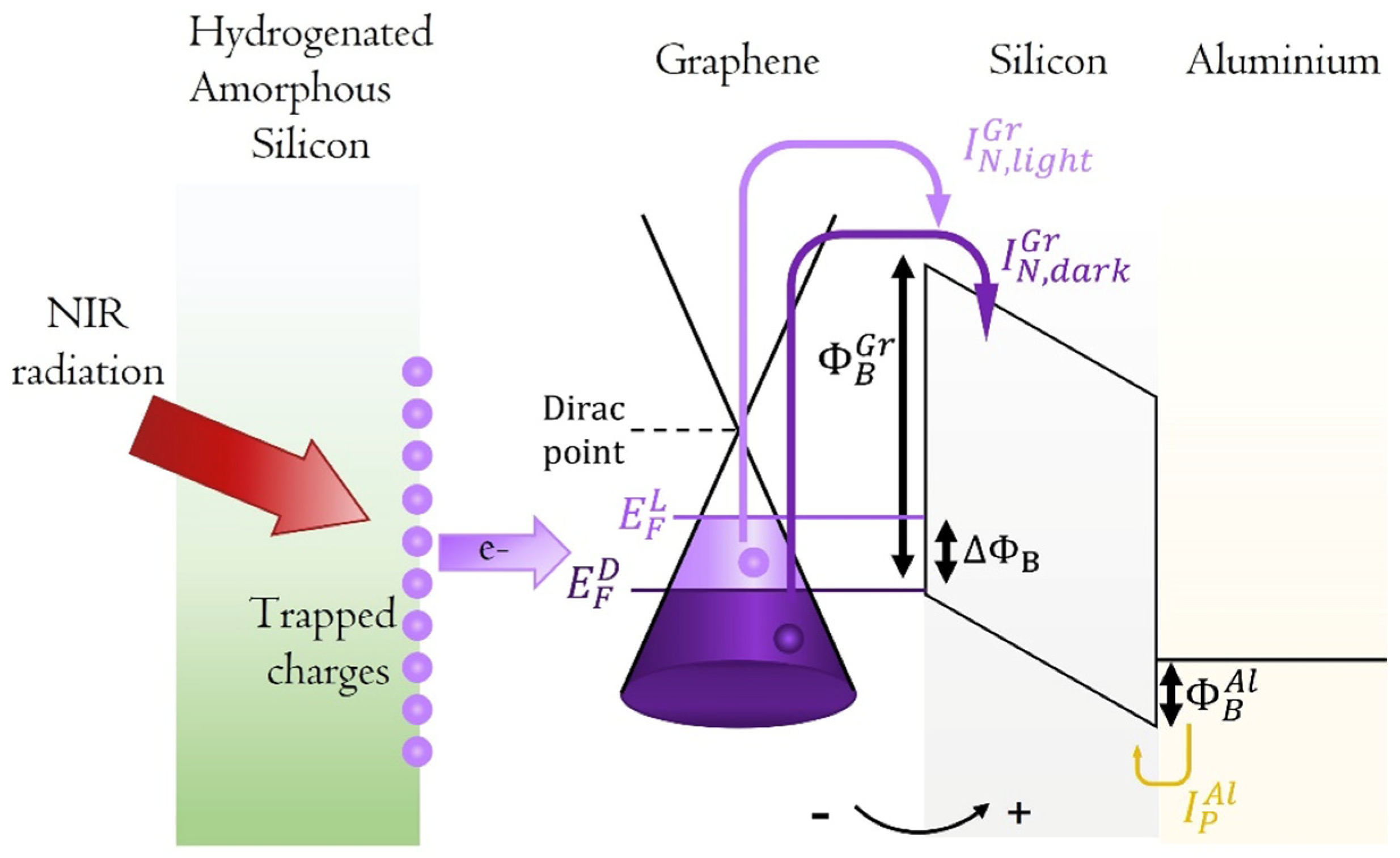
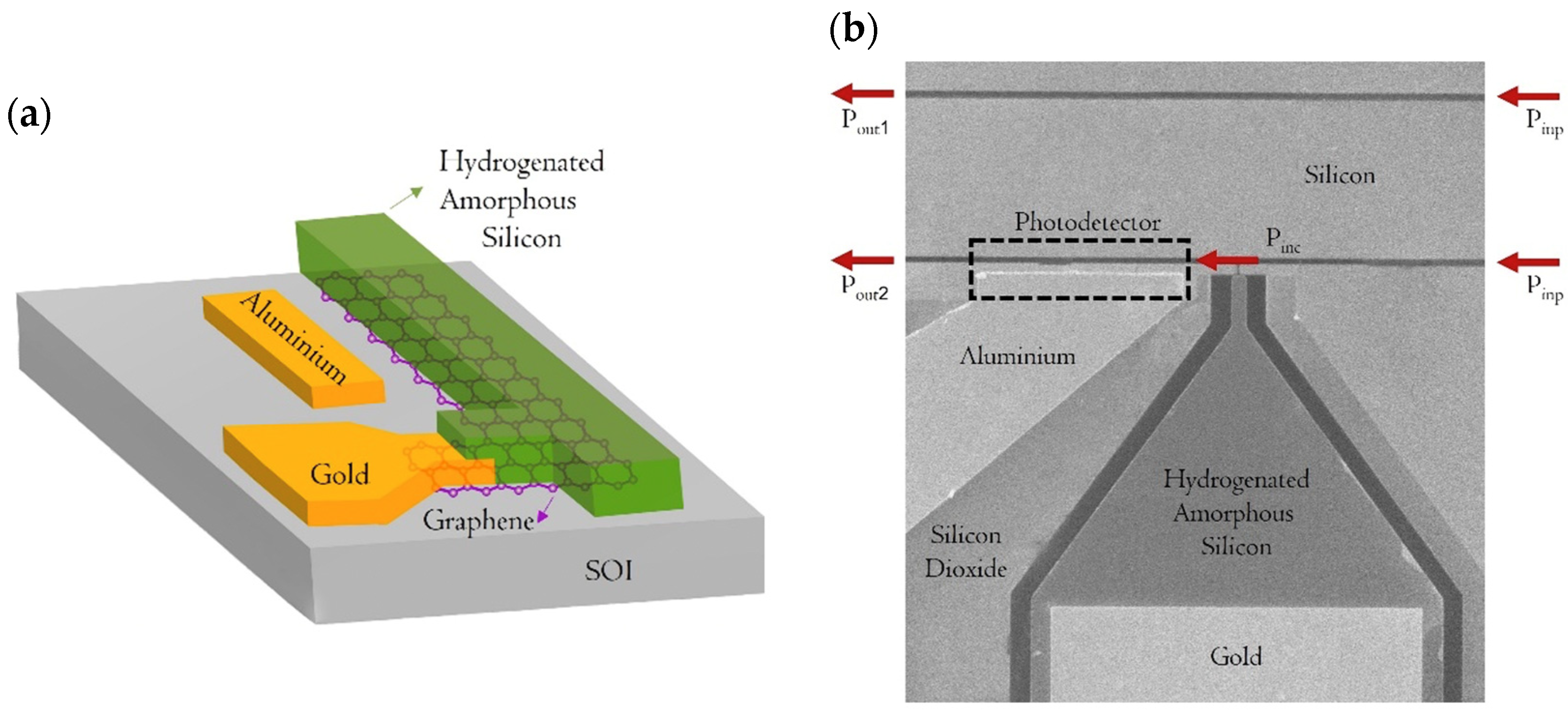
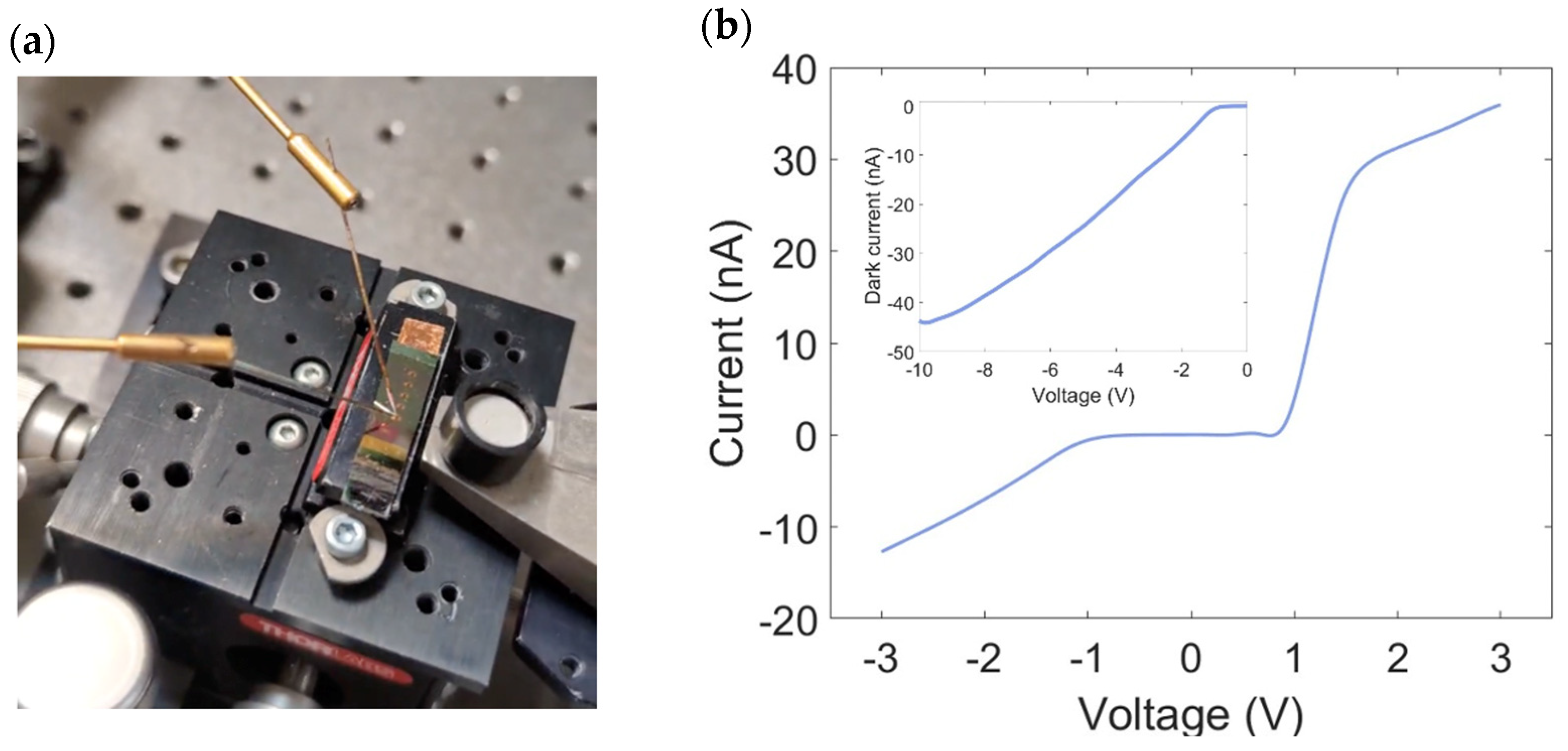
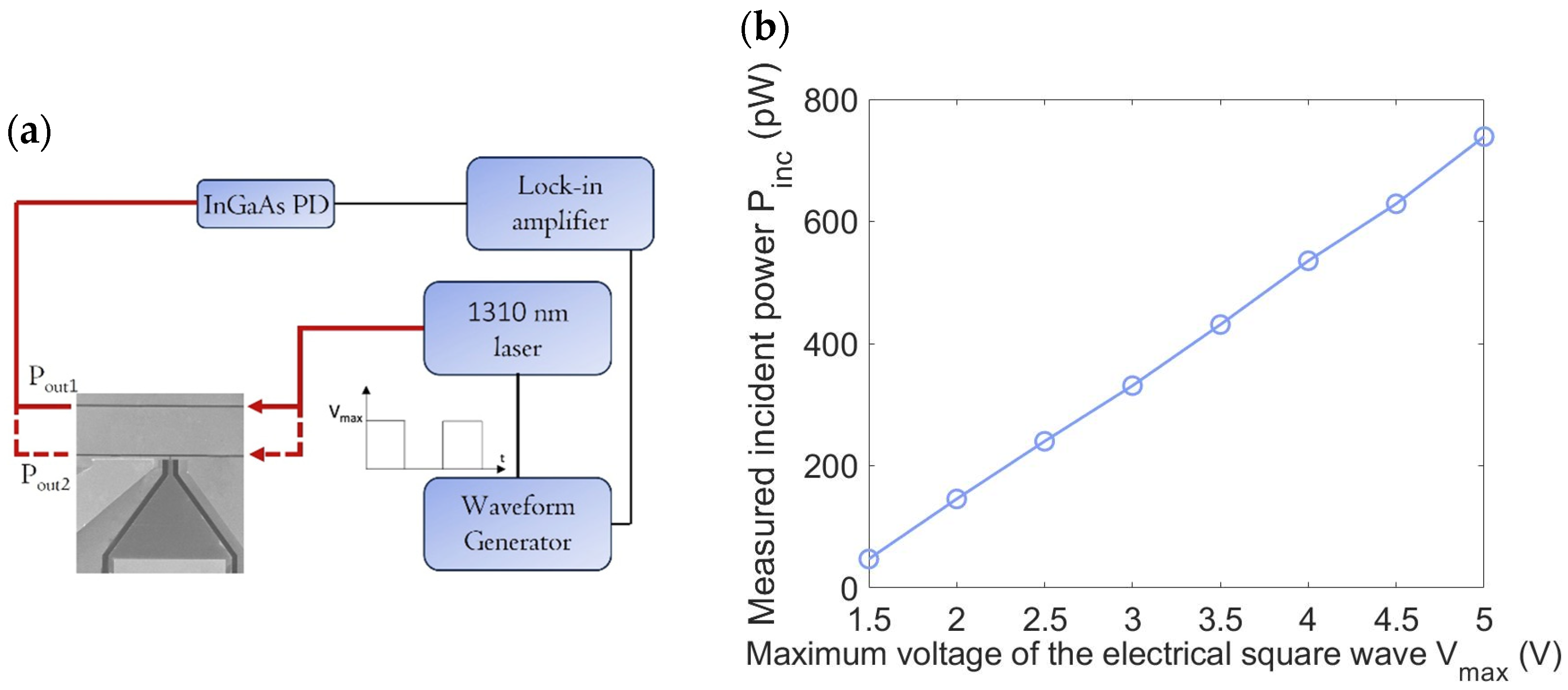

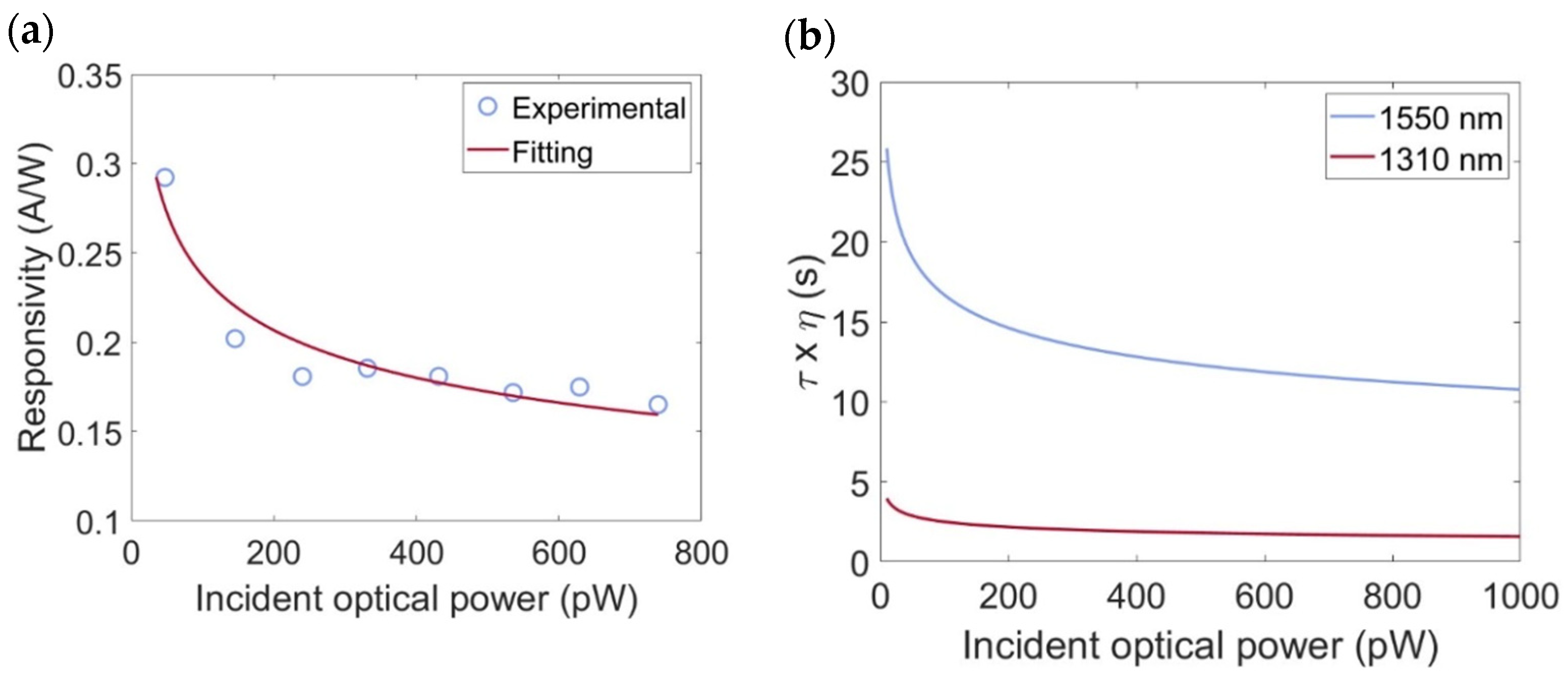
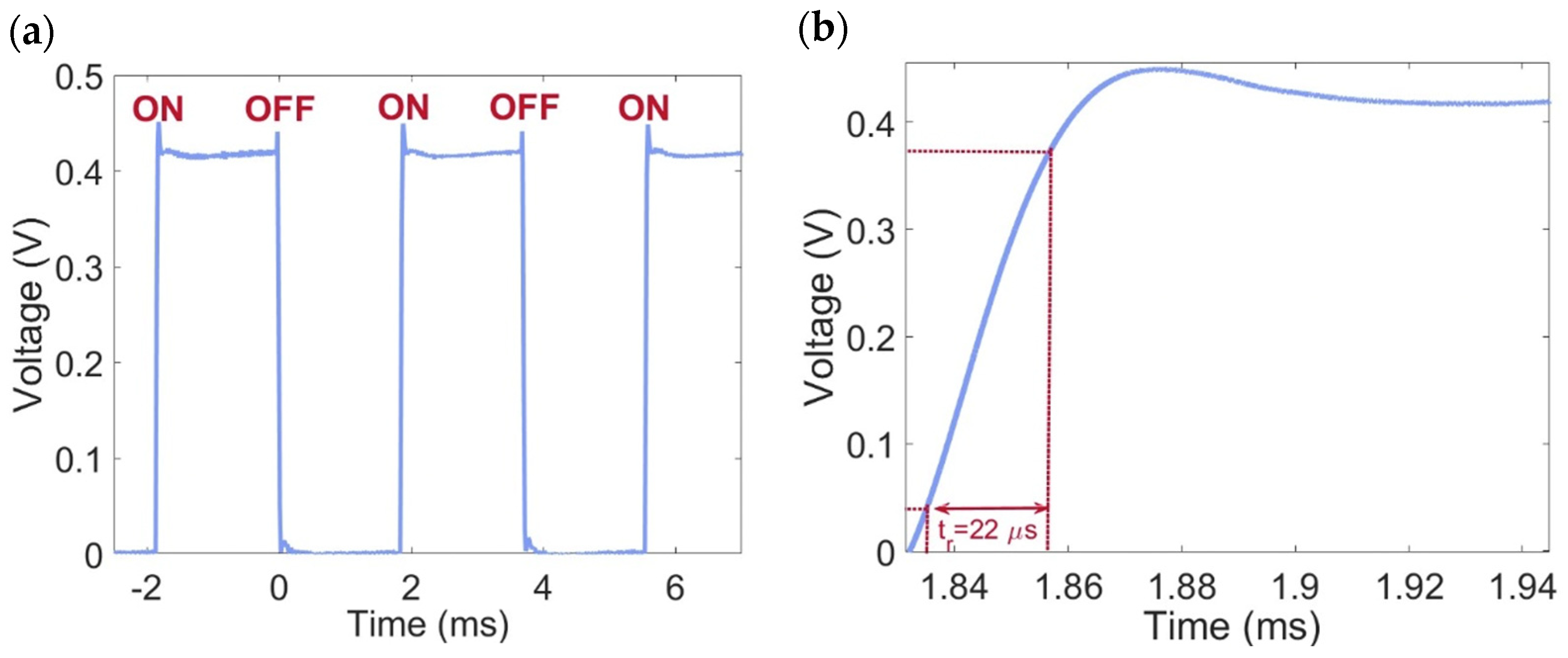
| Wavelength | Responsivity | NEP | Rise Time | Efficiency-Lifetime Product τ × η (Pinc) = α/(Pinc)β |
|---|---|---|---|---|
| 1310 nm | 0.3 A/W | 0.4 pWHz−1/2 | 22 μs | α = 0.025 × 10−6 sWβ β = 0.2 |
| 1550 nm [15] | 1.9 A/W | 9.6 pWHz−1/2 | - | α = 0.21 × 10−6 sWβ β = 0.19 |
Disclaimer/Publisher’s Note: The statements, opinions and data contained in all publications are solely those of the individual author(s) and contributor(s) and not of MDPI and/or the editor(s). MDPI and/or the editor(s) disclaim responsibility for any injury to people or property resulting from any ideas, methods, instructions or products referred to in the content. |
© 2025 by the authors. Licensee MDPI, Basel, Switzerland. This article is an open access article distributed under the terms and conditions of the Creative Commons Attribution (CC BY) license (https://creativecommons.org/licenses/by/4.0/).
Share and Cite
Crisci, T.; Moretti, L.; Gioffrè, M.; Hashemi, B.; Mammeri, M.; Della Corte, F.G.; Casalino, M. 1.3 Micron Photodetectors Enabled by the SPARK Effect. Micromachines 2025, 16, 440. https://doi.org/10.3390/mi16040440
Crisci T, Moretti L, Gioffrè M, Hashemi B, Mammeri M, Della Corte FG, Casalino M. 1.3 Micron Photodetectors Enabled by the SPARK Effect. Micromachines. 2025; 16(4):440. https://doi.org/10.3390/mi16040440
Chicago/Turabian StyleCrisci, Teresa, Luigi Moretti, Mariano Gioffrè, Babak Hashemi, Mohamed Mammeri, Francesco Giuseppe Della Corte, and Maurizio Casalino. 2025. "1.3 Micron Photodetectors Enabled by the SPARK Effect" Micromachines 16, no. 4: 440. https://doi.org/10.3390/mi16040440
APA StyleCrisci, T., Moretti, L., Gioffrè, M., Hashemi, B., Mammeri, M., Della Corte, F. G., & Casalino, M. (2025). 1.3 Micron Photodetectors Enabled by the SPARK Effect. Micromachines, 16(4), 440. https://doi.org/10.3390/mi16040440










